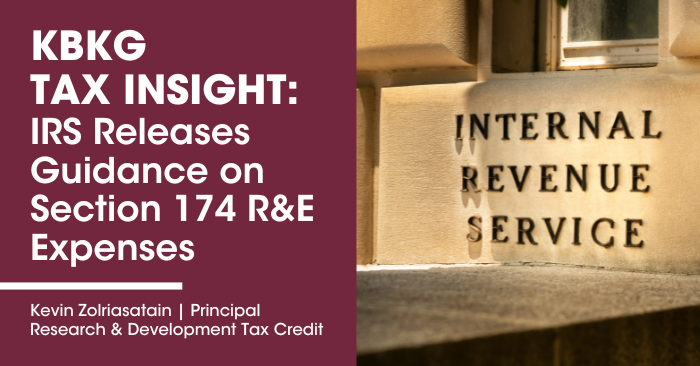KBKG Tax Insight:
IRS Releases Guidance on Section 174 R&E Expenses
Monday, September 11, 2023
By Kevin Zolriasatain | Principal, Research & Development Tax Credits
On Sept. 8, 2023, the Internal Revenue Service (IRS) unveiled Notice 2023-63. This significant and eagerly awaited update to tax regulations under Section 174 marks a pivotal moment in the realm of tax compliance, as it introduces essential guidance and changes to the way businesses can deduct research and experimental (R&E) expenses under Section 174 of the Internal Revenue Code. As companies continually strive to innovate and remain competitive, this fresh guidance promises to have extensive implications for businesses of all sizes, offering valuable insights into the tax treatment of R&D expenditures and potentially reshaping strategic financial planning for businesses.
The 2017 Tax Cuts and Jobs Act made significant changes to Section 174, which governs the treatment of specified research or experimental (SRE) expenditures. These changes are effective for expenses paid or incurred in tax years starting after Dec. 31, 2021. Under the amended Section 174(a), taxpayers are required to capitalize SRE expenditures, including costs related to software development. These expenditures must be amortized over a period of five years (or 15 years if they pertain to research conducted outside the United States). This means that instead of deducting these costs immediately, businesses must spread out the deduction over the specified amortization period.
SRE activities encompass both software development activities as defined in the notice and research or experimental activities according to § 1.174-2. These activities involve efforts to reduce uncertainty in product development, component improvement, or subcomponent design. The guidance defines allowable SRE expenditures, including:
- Labor costs
- Materials and supplies
- Cost recovery allowances
- Patent costs
- Certain operation
- Management costs
- Travel costs
However, it also outlines costs that are explicitly excluded from being treated as SRE expenditures, such as:
- General and administrative service department costs
- Interest on debt financing for SRE activities
- Certain specific activities
- Amortization amounts for specific expenditures.
This comprehensive guidance provides valuable insights into the tax treatment of these expenditures, aiding businesses in complying with tax regulations.
The IRS guidance also provides clarity regarding the treatment of costs incurred for research performed under contract, specifically addressing whether such costs qualify as SRE expenditures under § 174. The key terms defined include:
- Research Provider: the party performing research services or developing an SRE product
- Research Recipient: the party contracting research services or acquiring an SRE product
- Financial Risk: risk of financial loss for the research provider
- SRE Product: property subject to protection under applicable law, such as patents, computer software, etc.
The guidance stipulates that costs incurred by the research recipient should follow the principles of § 1.174-2(a)(10) and (b)(3). However, whether the costs incurred by the research provider qualify as a Section 174 expense depends on whether they bear financial risk under the contract. If the research provider bears financial risk, the costs related to SRE activities are considered SRE expenditures. Even if they don’t bear financial risk, but they have the right to use or exploit the resulting SRE product in their business, costs incurred are treated as SRE expenditures.
Notice 2023-63 offers much-needed clarity for businesses grappling with the complexities of Section 174 rules. However, it’s important to note that while this guidance brings transparency to the tax treatment of costs related to research, it may not be perceived as entirely friendly for the taxpayer. The stringent rules and restrictions surrounding the allocation and treatment of these expenses can pose challenges for businesses seeking to maximize deductions and promote innovation.
About the New Guidance on SRE Expenditures
Understanding the expenses included in Notice 2023-63 is essential for taxpayers, tax professionals, and businesses alike, as it directly impacts financial planning, compliance with tax laws, and the overall financial health of individuals and organizations. Below are some examples of expenses that should be captured as Section 174 Specified Research and Experimentation (SRE) expenses.
- Labor Costs: This includes the compensation for full-time, part-time, and contract employees, as well as independent contractors who directly work on, support, or supervise SRE activities. It covers various elements of compensation, such as basic pay, stock-based compensation, overtime, benefits, and more.
- Materials and Supplies Costs: These are costs for materials, supplies, tools, and equipment that are used in the performance of SRE activities or in direct support of these activities. These materials are not depreciable under § 168.
- Cost Recovery Allowances: This encompasses depreciation, amortization, or depletion allowances related to property used in SRE activities or their direct support. This includes property placed in service before Dec. 31, 2021.
- Patent Costs: It includes expenses incurred in obtaining a patent, such as attorney fees for patent applications.
- Certain Operation and Management Costs: These consist of overhead costs for facilities, equipment, and assets used in SRE activities. It covers expenses like rent, utilities, insurance, taxes, repairs, and security.
- Travel Costs: This category includes travel expenses incurred for the performance of SRE activities or their direct support.
Costs Not Treated as SRE Expenditures:
- Costs incurred by general and administrative service departments that indirectly support or benefit SRE activities.
- Interest on debt used to finance SRE activities.
- Costs for activities described in section 5.05 of notice 2023-63 related to Computer Software.
- Costs related to inputting content into a website.
- Costs for website hosting with specified periodic fees to Internet service providers.
- Costs for registering internet domain names or trademarks.
- Costs listed in § 1.174-2(a)(6)(i)-(vii).
- Amounts representing the amortization of SRE expenditures.
- Amounts representing the amortization of research or experimental expenditures incurred in taxable years beginning before January 1, 2022.
Allocation Method:
To determine total SRE expenditures for a taxable year, taxpayers must allocate costs to SRE activities based on a cause-and-effect relationship or another reasonable relationship that links the costs to the benefits provided to SRE activities. The allocation method can vary for different types of costs but must be applied consistently. For example, labor costs can be allocated based on the ratio of time spent on SRE activities to total time spent, while facility cost recovery allowances can be allocated based on square footage ratios. This consistent allocation method ensures compliance with tax regulations, even though it may not be appropriate for other sections of the tax code.
Full IRS Notice 2023-63:

Kevin Zolriasatain– Principal
Kevin is a Principal and Practice Leader of KBKG’s Research and Development (R&D) Tax Credit Services from our Pasadena headquarters. He has over 20 years of consulting experience providing R&D tax credit services to companies of various sizes. Prior to KBKG, he spent nearly a decade at PricewaterhouseCoopers, focusing on securing R&D Tax Credits for Fortune 500 companies. Kevin enjoys working with small to mid-size business owners and over his career has documented hundreds of millions of dollars in research credits.


